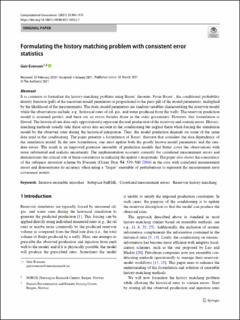| dc.contributor.author | Evensen, Geir | |
| dc.date.accessioned | 2022-01-18T08:25:11Z | |
| dc.date.available | 2022-01-18T08:25:11Z | |
| dc.date.created | 2020-11-05T09:48:15Z | |
| dc.date.issued | 2021 | |
| dc.identifier.citation | Computational Geosciences. 2021, . | en_US |
| dc.identifier.issn | 1420-0597 | |
| dc.identifier.uri | https://hdl.handle.net/11250/2837782 | |
| dc.description.abstract | It is common to formulate the history-matching problem using Bayes’ theorem. From Bayes’, the conditional probability density function (pdf) of the uncertain model parameters is proportional to the prior pdf of the model parameters, multiplied by the likelihood of the measurements. The static model parameters are random variables characterizing the reservoir model while the observations include, e.g., historical rates of oil, gas, and water produced from the wells. The reservoir prediction model is assumed perfect, and there are no errors besides those in the static parameters. However, this formulation is flawed. The historical rate data only approximately represent the real production of the reservoir and contain errors. History-matching methods usually take these errors into account in the conditioning but neglect them when forcing the simulation model by the observed rates during the historical integration. Thus, the model prediction depends on some of the same data used in the conditioning. The paper presents a formulation of Bayes’ theorem that considers the data dependency of the simulation model. In the new formulation, one must update both the poorly known model parameters and the rate-data errors. The result is an improved posterior ensemble of prediction models that better cover the observations with more substantial and realistic uncertainty. The implementation accounts correctly for correlated measurement errors and demonstrates the critical role of these correlations in reducing the update’s magnitude. The paper also shows the consistency of the subspace inversion scheme by Evensen (Ocean Dyn. 54, 539–560 2004) in the case with correlated measurement errors and demonstrates its accuracy when using a “larger” ensemble of perturbations to represent the measurement error covariance matrix. | en_US |
| dc.language.iso | eng | en_US |
| dc.rights | Navngivelse 4.0 Internasjonal | * |
| dc.rights.uri | http://creativecommons.org/licenses/by/4.0/deed.no | * |
| dc.title | Formulating the history matching problem with consistent error statistics | en_US |
| dc.type | Peer reviewed | en_US |
| dc.type | Journal article | en_US |
| dc.rights.holder | © The Author, 2021 | |
| dc.description.version | publishedVersion | en_US |
| cristin.ispublished | true | |
| cristin.fulltext | original | |
| cristin.qualitycode | 1 | |
| dc.identifier.doi | 10.1007/s10596-021-10032-7 | |
| dc.identifier.cristin | 1845123 | |
| dc.source.journal | Computational Geosciences | en_US |
| dc.source.pagenumber | 26 | en_US |
| dc.relation.project | Norges forskningsråd: 280473 | en_US |

